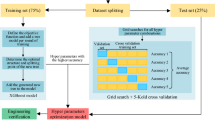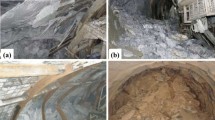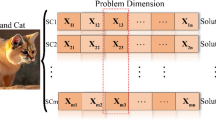Abstract
In production blasting, the primary goal is to produce an appropriate fragmentation, whereas an improper fragmentation is one of the most common side effects induced by these events. This investigation aims at predicting rock fragmentation through a new ansemble technique, namely light gradient-boosting machine (LightGBM) with its hyper-parameters that were tuned using a powerful optimization algorithm, i.e., the Jellyfish Search Optimizer (JSO). The hybrid JSO-LightGBM is responsible for obtaining the highest possible performance from a combination of these two models where the used database is collected from the Sungun copper mine, Iran. Some blasting pattern parameters such as stemming and spacing were used as input variables while the mean fragment size (D50), which is a valid indicator for rock fragmentation studies, was considered an output variable. As a result, the coefficient of determination (R2) of 0.990 on the training set and R2 of 0.996 on the testing set confirmed that the newly developed JSO-LightGBM model has a powerful capability for predicting rock fragmentation, and it can be used as a new methodology in this field. Furthermore, the correlations between the input variables and target output by the Shapley Additive exPlanations technique showed that the powder factor has the most significant impact on fragmentation.










Similar content being viewed by others
References
Abdelghany WK, Hammed MS, Radwan AE (2022) Implications of machine learning on geomechanical characterization and sand management: a case study from Hilal field, Gulf of Suez, Egypt. J Pet Explor Prod Technol 1–16
Armaghani DJ, Hajihassani M, Mohamad ET et al (2014) Blasting-induced flyrock and ground vibration prediction through an expert artificial neural network based on particle swarm optimization. Arab J Geosci 7:5383–5396
Armaghani DJ, Koopialipoor M, Bahri M et al (2020) A SVR-GWO technique to minimize flyrock distance resulting from blasting. Bull Eng Geol Environ. https://doi.org/10.1007/s10064-020-01834-7
Armaghani DJ, Mahdiyar A, Hasanipanah M et al (2016) Risk assessment and prediction of flyrock distance by combined multipleregression analysis and Monte Carlo simulation of quarry blasting. Rock Mech Rock Eng 49:1–11. https://doi.org/10.1007/s00603-016-1015-z
Azimi Y (2006) Investigation of seismic wave due to blasting in Sungun copper mine. Amirkabir University of Technology (Tehran Polytechnic), MSc Iran
Azimi Y, Khoshrou SH, Osanloo M (2019) Prediction of blast induced ground vibration (BIGV) of quarry mining using hybrid genetic algorithm optimized artificial neural network. Measurement 147:106874. https://doi.org/10.1016/J.MEASUREMENT.2019.106874
Bahadori M, Bakhshandeh Amnieh H, Khajezadeh A (2016) A new geometrical-statistical algorithm for predicting two-dimensional distribution of rock fragments caused by blasting. Int J Rock Mech Min Sci 86:55–64. https://doi.org/10.1016/j.ijrmms.2016.04.002
Bahrami A, Monjezi M, Goshtasbi K, Ghazvinian A (2011) Prediction of rock fragmentation due to blasting using artificial neural network. Eng Comput 27:177–181
Bakhtavar E, Khoshrou H, Badroddin M (2015) Using dimensional-regression analysis to predict the mean particle size of fragmentation by blasting at the Sungun copper mine. Arab J Geosci 8:2111–2120
Bastian T, Lilley MKS, Beggs SE et al (2014) Ecosystem relevance of variable jellyfish biomass in the Irish Sea between years, regions and water types. Estuar Coast Shelf Sci 149:302–312. https://doi.org/10.1016/j.ecss.2014.08.018
Buitinck L, Louppe G, Blondel M et al (2013) API design for machine learning software: experiences from the scikit-learn project. 1–15
Chen T, Xu J, Ying H et al (2019) Prediction of extubation failure for intensive care unit patients using light gradient boosting machine. IEEE Access 7:150960–150968. https://doi.org/10.1109/ACCESS.2019.2946980
Chou JS, Truong DN (2021) A novel metaheuristic optimizer inspired by behavior of jellyfish in ocean. Appl Math Comput 389:125535. https://doi.org/10.1016/j.amc.2020.125535
Dhekne P, Pradhan M, Jade RK (2016) Assessment of the effect of blast hole diameter on the number of oversize boulders using ANN model. J Inst Eng Ser D 97:21–31. https://doi.org/10.1007/s40033-015-0083-7
Dimitraki L, Christaras B, Marinos V et al (2019) Predicting the average size of blasted rocks in aggregate quarries using artificial neural networks. Bull Eng Geol Environ 78:2717–2729. https://doi.org/10.1007/s10064-018-1270-1
Ebrahimi E, Monjezi M, Khalesi MR, Armaghani DJ (2016) Prediction and optimization of back-break and rock fragmentation using an artificial neural network and a bee colony algorithm. Bull Eng Geol Environ 75:27–36
Faradonbeh RS, Armaghani DJ, Monjezi M (2016) Development of a new model for predicting flyrock distance in quarry blasting: a genetic programming technique. Bull Eng Geol Environ 75:993–1006
Gheibie S, Aghababaei H, Hoseinie S, Pourrahimian Y (2009) Modified Kuz—Ram fragmentation model and its use at the Sungun Copper Mine. Int J Rock Mech Min Sci 46:967–973
Ghiasi M, Askarnejad N, Dindarloo SR, Shamsoddini H (2016) Prediction of blast boulders in open pit mines via multiple regression and artificial neural networks. Int J Min Sci Technol 26:183–186
Hajihassani M, Jahed Armaghani D, Monjezi M et al (2015) Blast-induced air and ground vibration prediction: a particle swarm optimization-based artificial neural network approach. Environ Earth Sci 74:2799–2817. https://doi.org/10.1007/s12665-015-4274-1
Hasanipanah M, Jahed Armaghani D, Monjezi M, Shams S (2016) Risk assessment and prediction of rock fragmentation produced by blasting operation: a rock engineering system. Environ Earth Sci 75. https://doi.org/10.1007/s12665-016-5503-y
Hasanipanah M, Monjezi M, Shahnazar A et al (2015) Feasibility of indirect determination of blast induced ground vibration based on support vector machine. Measurement 75:289–297
He B, Armaghani DJ, Lai SH (2022a) A short overview of soft computing techniques in tunnel construction. Open Constr Build Technol J 16:1–6. https://doi.org/10.2174/18748368-v16-e2201120
He B, Lai SH, Mohammed AS et al (2022b) Estimation of blast-induced peak particle velocity through the improved weightedrandom forest technique. Appl Sci 12:5019. https://doi.org/10.3390/app12105019
Hong WC, Dong Y, Chen LY, Wei SY (2011) SVR with hybrid chaotic genetic algorithms for tourism demand forecasting. Appl Soft Comput J 11:1881–1890. https://doi.org/10.1016/j.asoc.2010.06.003
Huang J, Asteris PG, Pasha SMK et al (2020) A new auto-tuning model for predicting the rock fragmentation: a cat swarm optimization algorithm. Eng Comput. https://doi.org/10.1007/s00366-020-01207-4
Huat CY, Moosavi SMH, Mohammed AS et al (2021) Factors influencing pile friction bearing capacity: proposing a novel procedure based on gradient boosted tree technique. Sustainability 13:11862
Hudaverdi T, Akyildiz O (2019) A new classification approach for prediction of flyrock throw in surface mines. Bull Eng Geol Environ 78:177–187
Hustrulid WA (1999) Blasting principles for open pit mining: general design concepts. Balkema, Amsterdam
Inanloo Arabi Shad H, Sereshki F, Ataei M, Karamoozian M (2018) Investigation of rock blast fragmentation based on specific explosive energy and in-situ block size. Int J Min Geo-Engineering 52:2–7
Jafarizadeh F, Rajabi M, Tabasi S et al (2022) Data driven models to predict pore pressure using drilling and petrophysical data. Energy Rep 8:6551–6562
Jahed Armaghani D, Hajihassani M, Monjezi M et al (2015) Application of two intelligent systems in predicting environmental impacts of quarry blasting. Arab J Geosci 8:9647–9665. https://doi.org/10.1007/s12517-015-1908-2
Ke G, Meng Q, Finley T et al (2017) LightGBM: A highly efficient gradient boosting decision tree. Adv Neural Inf Process Syst 2017-Decem:3147–3155
Koopialipoor M, Jahed Armaghani D, Haghighi M, Ghaleini EN (2017) A neuro-genetic predictive model to approximate overbreak induced by drilling and blasting operation in tunnels. Bull Eng Geol Environ. https://doi.org/10.1007/s10064-017-1116-2.10.1007/s10064-017-1116-2
Kulatilake P, Qiong W, Hudaverdi T, Kuzu C (2010) Mean particle size prediction in rock blast fragmentation using neural networks. Eng Geol 114:298–311
Latham J, Munjiza A, Lu P (1999) Rock fragmentation by blasting - a literature study of research in the 1980’s and 1990’s. Fragblast 3:193–212. https://doi.org/10.1080/13855149909408046
Lawal AI (2021) A new modification to the Kuz-Ram model using the fragment size predicted by image analysis. Int J Rock Mech Min Sci 138:104595. https://doi.org/10.1016/j.ijrmms.2020.104595
Li D, Liu Z, Armaghani DJ et al (2022a) Novel ensemble tree solution for rockburst prediction using deep forest. Mathematics 10:787
Li E, Yang F, Ren M et al (2021) Prediction of blasting mean fragment size using support vector regression combined with five optimization algorithms. J Rock Mech Geotech Eng 13:1380–1397. https://doi.org/10.1016/j.jrmge.2021.07.013
Li K, Xu H, Liu X (2022b) Analysis and visualization of accidents severity based on LightGBM-TPE. Chaos, Solitons and Fractals 157:111987. https://doi.org/10.1016/j.chaos.2022.111987
Liu Z, Armaghani DJ, Fakharian P et al (2022) Rock strength estimation using several tree-based ML techniques. C Model Eng Sci. https://doi.org/10.32604/cmes.2022.021165
Lundberg SM, Erion G, Chen H et al (2020) From local explanations to global understanding with explainable AI for trees. Nat Mach Intell 2:56–67. https://doi.org/10.1038/s42256-019-0138-9
Lundberg SM, Erion GG, Lee S-I (2018) Consistent individualized feature attribution for tree ensembles
Lundberg SM, Lee SI (2017) A unified approach to interpreting model predictions. Adv Neural Inf Process Syst 30:
Momeni E, Yarivand A, Dowlatshahi MB, Armaghani DJ (2020) An efficient optimal neural network based on gravitational search Algorithm in Predicting the Deformation of Geogrid-Reinforced Soil Structures. Transp Geotech 100446
Monjezi M, Rezaei M, Varjani AY (2009) Prediction of rock fragmentation due to blasting in Gol-E-Gohar iron mine using fuzzy logic. Int J Rock Mech Min Sci 46:1273–1280
Moosavi SMH, Ma Z, Armaghani DJ et al (2022) Understanding and predicting the usage of shared electric scooter services on university campuses. Appl Sci 12:9392
Morin MA, Ficarazzo F (2006) Monte Carlo simulation as a tool to predict blasting fragmentation based on the Kuz-Ram model. Comput Geosci 32:352–359
Murlidhar BR, Armaghani DJ, Mohamad ET, Changthan S (2018) Rock fragmentation prediction through a new hybrid model based on imperial competitive algorithm and neural network. Smart Constr Res 2:1–12
Qi, C., Wu, M., Liu, H., Liang, Y., Liu, X., & Lin, Z. (2023). Machine learning exploration of the mobility and environmental assessment of toxic elements in mining-associated solid wastes. Journal of Cleaner Production, 136771.
Nguyen H, Bui X-N, Choi Y et al (2021) A novel combination of whale optimization algorithm and support vector machine with different kernel functions for prediction of blasting-induced fly-rock in quarry mines. Nat Resour Res 30:191–207. https://doi.org/10.1007/s11053-020-09710-7
Ohadi B, Sun X, Esmaieli K, Consens MP (2020) Predicting blast-induced outcomes using random forest models of multi-year blasting data from an open pit mine. Bull Eng Geol Environ 79:329–343
He, B., Armaghani, D. J., & Lai, S. H. (2023). Assessment of tunnel blasting-induced overbreak: A novel metaheuristic-based random forest approach. Tunnelling and Underground Space Technology, 133, 104979.
Rajabi M, Beheshtian S, Davoodi S et al (2021) Novel hybrid machine learning optimizer algorithms to prediction of fracture density by petrophysical data. J Pet Explor Prod Technol 11:4375–4397
Rajabi M, Hazbeh O, Davoodi S et al (2022) Predicting shear wave velocity from conventional well logs with deep and hybrid machine learning algorithms. J Pet Explor Prod Technol 1–24
Safaei-Farouji M, Thanh HV, Dai Z et al (2022) Exploring the power of machine learning to predict carbon dioxide trap** efficiency in saline aquifers for carbon geological storage project. J Clean Prod 372:133778
Sayadi A, Monjezi M, Talebi N, Khandelwal M (2013) A comparative study on the application of various artificial neural networks to simultaneous prediction of rock fragmentation and backbreak. J Rock Mech Geotech Eng 5. https://doi.org/10.1016/j.jrmge.2013.05.007
Shan F, He X, Armaghani DJ et al (2022) Success and challenges in predicting TBM penetration rate using recurrent neural networks. Tunn Undergr Sp Technol 130:104728
Shi X, Huang D, Zhou J, Zhang S (2013) Combined ANN prediction model for rock fragmentation distribution due to blasting. J Inf Comput Sci 10:3511–3518
Tawadrous A (2006) Evaluation of artificial neural networks as a reliable tool in blast design. Proc Annu Conf Explos Blasting Tech 32:71
Taylor P, Kanchibotla SS (2010) Fragblast : International journal for blasting and fragmentation optimum blasting ? Is it minimum cost per broken rock or maximum value per broken rock ? Optimum blasting ? Is it minimum cost per broken rock or maximum value per broken rock ? Ã. 37–41
Thornton D, Kanchibotla SS, Brunton I (2002) Modelling the impact of rockmass and blast design variation on blast fragmentation. Fragblast 6:169–188. https://doi.org/10.1076/frag.6.2.169.8663
Wen X, **e Y, Wu L, Jiang L (2021) Quantifying and comparing the effects of key risk factors on various types of roadway segment crashes with LightGBM and SHAP. Accid Anal Prev 159:106261. https://doi.org/10.1016/j.aap.2021.106261
**e C, Nguyen H, Bui XN et al (2021) Predicting rock size distribution in mine blasting using various novel soft computing models based on meta-heuristics and machine learning algorithms. Geosci Front 12:101108. https://doi.org/10.1016/j.gsf.2020.11.005
Yang H, Song K, Zhou J (2022) Automated recognition model of geomechanical information based on operational data of tunneling boring machines. Rock Mech Rock Eng. https://doi.org/10.1007/s00603-021-02723-5
Yang H, Wang Z, Song K (2020) A new hybrid grey wolf optimizer-feature weighted-multiple kernel-support vector regression technique to predict TBM performance. Eng Comput. https://doi.org/10.1007/s00366-020-01217-2
Zhang J (2001) Fragment-size theory of blasting in rock mass and its application. Southwest University Press, Chengdu
Author information
Authors and Affiliations
Corresponding author
Ethics declarations
Conflict of interest
The authors declare no competing interests.
Rights and permissions
Springer Nature or its licensor (e.g. a society or other partner) holds exclusive rights to this article under a publishing agreement with the author(s) or other rightsholder(s); author self-archiving of the accepted manuscript version of this article is solely governed by the terms of such publishing agreement and applicable law.
About this article
Cite this article
Yari, M., He, B., Armaghani, D.J. et al. A novel ensemble machine learning model to predict mine blasting–induced rock fragmentation. Bull Eng Geol Environ 82, 187 (2023). https://doi.org/10.1007/s10064-023-03138-y
Received:
Accepted:
Published:
DOI: https://doi.org/10.1007/s10064-023-03138-y




